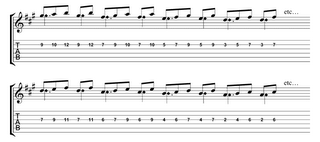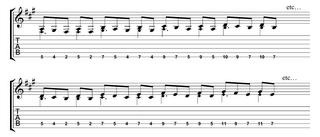playing in position pt. 7b: learning the geography (again)
Let’s continue where we left off last time:
 As we’ve already covered, when you play in position all fingers behind the stopping finger should be touching the strings. So, for instance, in the case of the first three notes of pattern A the resulting fingers on the ’board should be finger 1 (C#), fingers 1+2 (D), and fingers 1+2+3+4 (E).
As we’ve already covered, when you play in position all fingers behind the stopping finger should be touching the strings. So, for instance, in the case of the first three notes of pattern A the resulting fingers on the ’board should be finger 1 (C#), fingers 1+2 (D), and fingers 1+2+3+4 (E).
In line with our last excursion in learning the geography, let’s repeat the patterns going down, but this time following the major mode’s (A major’s, in this case) arrangement of intervals. Continue the process across the strings:
Continue the process across the strings: Incidentally, note how the three patterns that we marked A, B and C (and the corresponding hand shapes) recur. There’s nothing particularly magical about this, it’s simply a side effect of how a major mode is constructed, but it does make your life a little easier.
Incidentally, note how the three patterns that we marked A, B and C (and the corresponding hand shapes) recur. There’s nothing particularly magical about this, it’s simply a side effect of how a major mode is constructed, but it does make your life a little easier.
Now ascending: Try different scales/patterns, and, as with the last time, once you’re comfortable with this, fire up the metronome, vary the rhythms, articulation and phrasing, add a little swing, etc. Be creative.
Try different scales/patterns, and, as with the last time, once you’re comfortable with this, fire up the metronome, vary the rhythms, articulation and phrasing, add a little swing, etc. Be creative.
By the way, in addition to making reasonable warm-ups (but only in moderation and in combination with other tasks), these exercises are also an effective tools for getting acquainted with new or non-standard tunings.


No comments:
Post a Comment